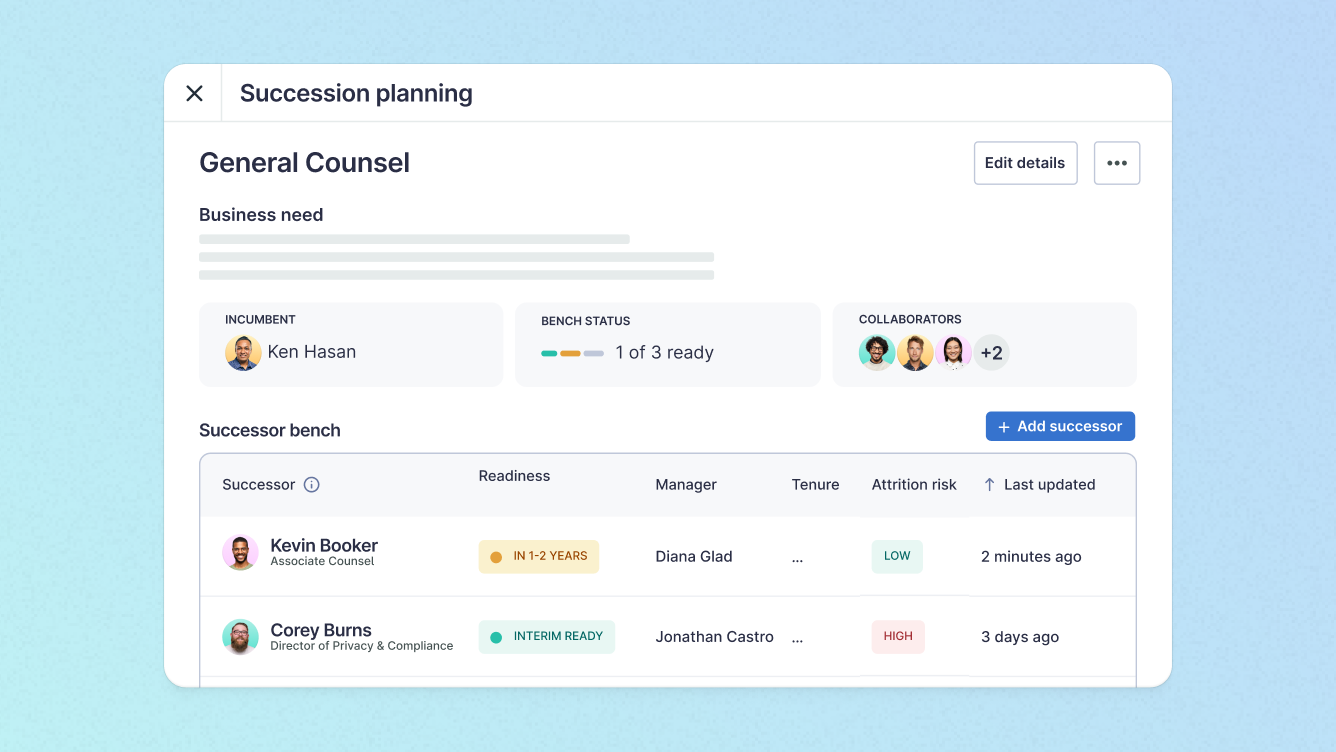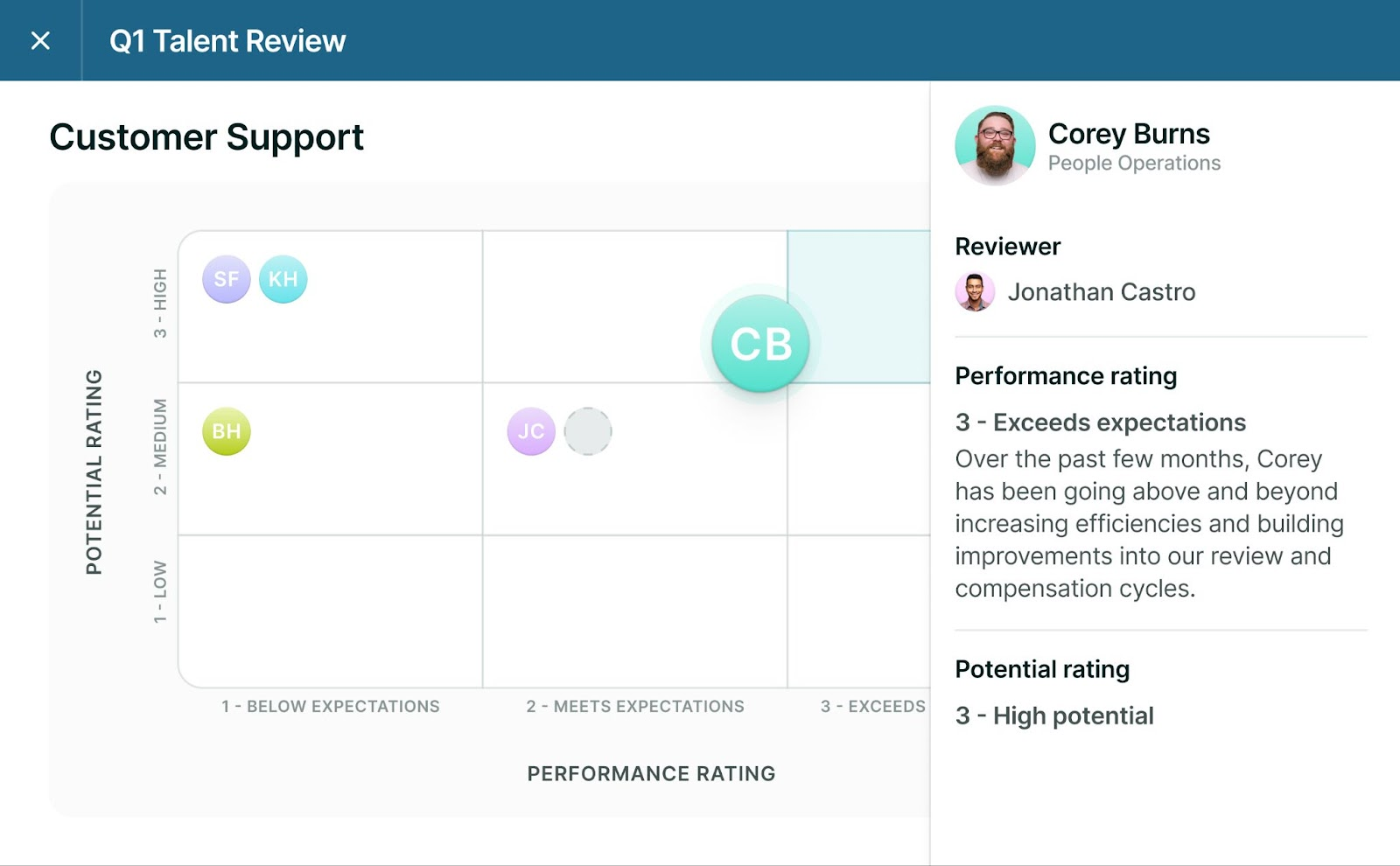What would you do if one of your top employees quit tomorrow? Would it be business as usual, or would performance and productivity suffer as you try to recruit a replacement? And do you even have the bench strength in the organization to fill every business-critical role?
Enter the succession plan. Instead of scrambling to find new talent, a succession plan means you can quickly harness your existing employees to bring their leadership skills and drive to take over the role. Here, we’ll look at how succession planning can safeguard your business performance, and help you prepare a contingency action plan for your organization.
What is succession planning?
Succession planning is the process of proactively looking for key talent and potential leaders within (or beyond) your existing workforce, to preserve business continuity when critical roles become vacant.
When a senior leader such as a VP, director, or department head announces their intention to retire or move on to another company, a succession plan sets out the procedures for identifying, recruiting, and mentoring their replacement ahead of time, to promote a smooth transition. If an employee unexpectedly resigns, falls ill, or takes maternity leave, your succession plan is your safety net for ensuring their responsibilities are covered.
It’s not just about promotion either. Succession planning can also support employees in moving laterally across the organization into new teams that better suit their skill sets.

Succession planning is not the same as career pathing. Career pathing is about mapping all the roles an employee could potentially hold in your organization. Succession planning focuses on roles — particularly business-critical positions. It addresses specific organizational needs rather than individual aspirations and progression.
Curious about career pathing? Take a look at our career tracks workbook to learn how to capture employees’ competencies and expectations.
The Benefits of Succession Planning
There are many reasons to incorporate a succession planning strategy into your talent management processes.
Reduce your time-to-fill.
The longer it takes to fill a role, the greater the burden on your other employees. This disruption impacts productivity, employee engagement, and morale, and can lead to burnout. A succession plan helps to minimize the time a position is vacant while remaining strategic and avoiding rash hiring decisions.
“The goal is to always think two to three steps ahead, and hire and nurture high-performing individuals,” said Cindy Deuser, vice president of people operations at Thrive Internet Marketing Agency. “Change is inevitable, but companies need to evolve to maintain their competitive edge.”
Improve employee retention.
Developing a strong succession plan lets you handle employee departures in stride. You can quickly fill a vacant role with internal talent, which can have several positive benefits for the organization. Recruiting internally can help you keep top talent around longer and show employees that your business values and invests in internal growth. This can improve employee retention and raise morale.
“It’s important to remember that talented people will always have opportunities,” said Matthew Burr, human resources consultant and owner of Burr Consulting, LLC, which provides strategic HR services. “If an organization does not develop its own talent, your employees might be less likely to stay with your organization and more likely to seek outside career growth opportunities.”
Identify skills gaps.
Succession planning involves auditing and assessing the company’s existing roles and skills. This helps you home in on critical skills gaps and development opportunities within the organization.
“While succession planning allows you to better know the strengths of your workforce, it also brings into focus their potential weaknesses,” noted Burr.
Build better upskilling initiatives.
Recognizing the key skills your internal talent pool lacks can direct your learning and development (L&D) programs, with an eye to succession planning. Incorporating leadership training into your succession plan can help improve your business’s bench strength and resilience for the next generation of leaders.
Support employee engagement.
In our 2025 State of People Strategy Report, HR professionals identified ways to increase employee engagement aside from additional compensation. The top three were:
- L&D opportunities
- Accessible career paths
- Clear performance expectations
Succession planning supports all three approaches to employee engagement: offering targeted L&D opportunities to prepare employees with leadership potential for future roles, creating accessible career paths through succession pipelines, and setting clear performance expectations tied to advancement.
Promote equitable talent development.
Succession planning supports DEIB (diversity, equity, inclusion, and belonging) and gives HR teams a clear view of how employees progress through the ranks of the organization, making it harder for unconscious biases to steer promotion decisions. Succession planning can help make sure that companies build a diverse pipeline of future leaders for key roles. Given that research consistently shows that diverse teams are likely to financially outperform their less inclusive counterparts, equitable succession planning is a smart move for HR teams.
Avoid wage compression.
Succession planning helps keep wages fairer, by proactively preparing existing employees for leadership roles, rather than hiring external candidates at market rates that exceed existing employees’ salaries. As a result, it can also help to prevent the resentment or turnover that could arise if new hires earn more than tenured staff with similar or greater experience.
How to Implement a Succession Planning Process
One of the key findings in our 2025 State of People Strategy Report was how important it is for HR and managers to partner closely on people initiatives — and succession planning is no exception.

Here’s a step-by-step guide to working with your management team to build a succession plan that supports your organizational goals:
1. Identify business-critical roles.
The first step is to establish which key roles should have succession plans. Consider:
- Roles that could seriously impact day-to-day operations or performance if suddenly vacated
- Roles with an expected or likely endpoint — for example, if the employee currently in the role is approaching retirement age
- Roles that would be difficult to find a replacement for, such as highly technical roles that you’ve had trouble filling externally
Ask managers and department heads to identify and address the skills gaps and talent needs of their departments and critical positions. Their internal knowledge can be invaluable for informing an effective succession plan.
2. Define succession criteria.
Your succession plan must be comprehensive, fair, and equitable. To make sure you cover all the bases in sourcing the best candidates and implementing the plan effectively, set out the key criteria and metrics you need to meet for a candidate to be right for the role, such as:
- Required technical expertise
- Key competencies of the role
- Leadership abilities
3. Complete a talent assessment.
With the required leadership skills and competencies defined, you can now move to identifying high-potential employees who would fit the profile.
Talent reviews are a useful tool for this purpose. They assess not only individual workers but also the workforce as a whole. More than just performance reviews, talent reviews strategically evaluate key employees' growth potential and succession suitability.

4. Approach promising internal talent.
After identifying qualified employees, approach them about the position and discuss its alignment with their career aspirations.
- Explain your plan and why a succession plan is important for this role.
- Detail why you consider them a potential replacement if or when a vacancy arises.
- Gauge their interest in the position, using the role’s job description.
- If they are interested, detail the succession plan.
Of course, you may discover that you don’t have the internal talent necessary. This indicates the need to recruit externally and highlights organizational skills gaps to target with long-term internal training programs and development plans.
5. Invest in employee development and training.
Upskilling and reskilling potential successors for a future leadership role are essential elements of succession planning. Here are some key talent development strategies to employ.
- Training courses: Incorporate training specific to the targeted positions into your L&D strategy. This could be in-person leadership development programs, e-learning courses, or microlearning tasks in the flow of work. Target the hard and soft skills necessary for the role. Assigning hands-on stretch assignments helps candidates move beyond their usual job responsibilities and lets you assess their leadership skills in the face of a new challenge.
- Mentoring: Mentorship lets more junior employees tap the knowledge and experience of their senior colleagues to accelerate their learning and growth, identify and work on their strengths and weaknesses, get a second opinion and sound advice, and guide their professional development.
- Job shadowing: When there is prior notice of a vacancy, job shadowing creates a valuable opportunity for the candidate to learn from their predecessor. “This is particularly useful when someone is due to retire,” said Carole Burman, founder and managing director of MAD-HR, a UK-based HR consultancy. “The opportunity to have them work alongside their replacement means that you don’t lose their institutional knowledge and domain expertise.”
- Job rotation: Job rotation lets candidates sample different roles within the organization for a few days or a few months, allowing them to familiarize themselves with different aspects of the business quickly. This immersive learning empowers employees to grow their experience personally — not just by hearing information secondhand from others. They can pick up key skill sets to enhance their current and future roles.
For example, an employee preparing to take over the customer experience lead at a packaged goods company might rotate through product development, fulfillment, quality assurance, and packaging development teams to get a well-rounded understanding of the product and the process it follows to get to a customer.
{{rich-highlight-2}}
6. Develop your transition process.
Working with leadership teams and candidates, establish a systematic process for moving a new person into the role:
- Decide who will be involved in overseeing the succession process, such as HR staff, line managers, senior management, or board members.
- Establish timelines and milestones for the succession process.
- Set out the institutional knowledge transfer process, including listing key documentation and access rights.
- Specify any training, coaching, or performance management that will be involved.
- Detail the formal handover process with external and internal stakeholders to introduce and endorse the successor.
- If there is potential for crossover between the incumbent employee and their successor, arrange for handover meetings or mentorship sessions.
- Set out the communication strategy for keeping all stakeholders up to speed with the process.
- Check that there is ongoing support from HR and leadership teams to help the new person settle into the role.
For example, for a succession plan for a retiring executive, you may incorporate a shadowing or mentorship period to assist with an easier handover. If safeguarding a business-critical role, the succession plan could include procedures for key tasks that can be immediately adopted by an incoming replacement without notice.
7. Monitor and update your plan according to learnings.
Preparing for the unexpected means acknowledging that situations change rapidly. This goes for succession plans, too, so it’s important to review and revise your succession plans regularly. For example, a candidate earmarked for a key position could leave the company before a vacancy arises. Regularly updating your succession plans means you’ll have a pipeline of qualified candidates ready to step in.
{{rich-highlight-1}}
Future-proof your talent management with Lattice.

Effective succession planning means you can prepare for the future, in the present. That said, to have a truly successful succession plan, you need to keep in mind the direction and speed at which your company is moving.
“When it comes to succession planning, it’s important to recognize that it’s not a process where one size fits all,” Burman stressed. “You need to know which direction your business is heading in and what skills and knowledge will be required for the future. You don’t want to waste your time developing someone for a role that won’t exist in a year.”
To find out how the Lattice platform can support your organization’s long-term success, book a demo.

Make your plan ahead of time.
Need support in creating a succession plan? Use our free template that can be adapted and customized to fit your company’s leadership team.








